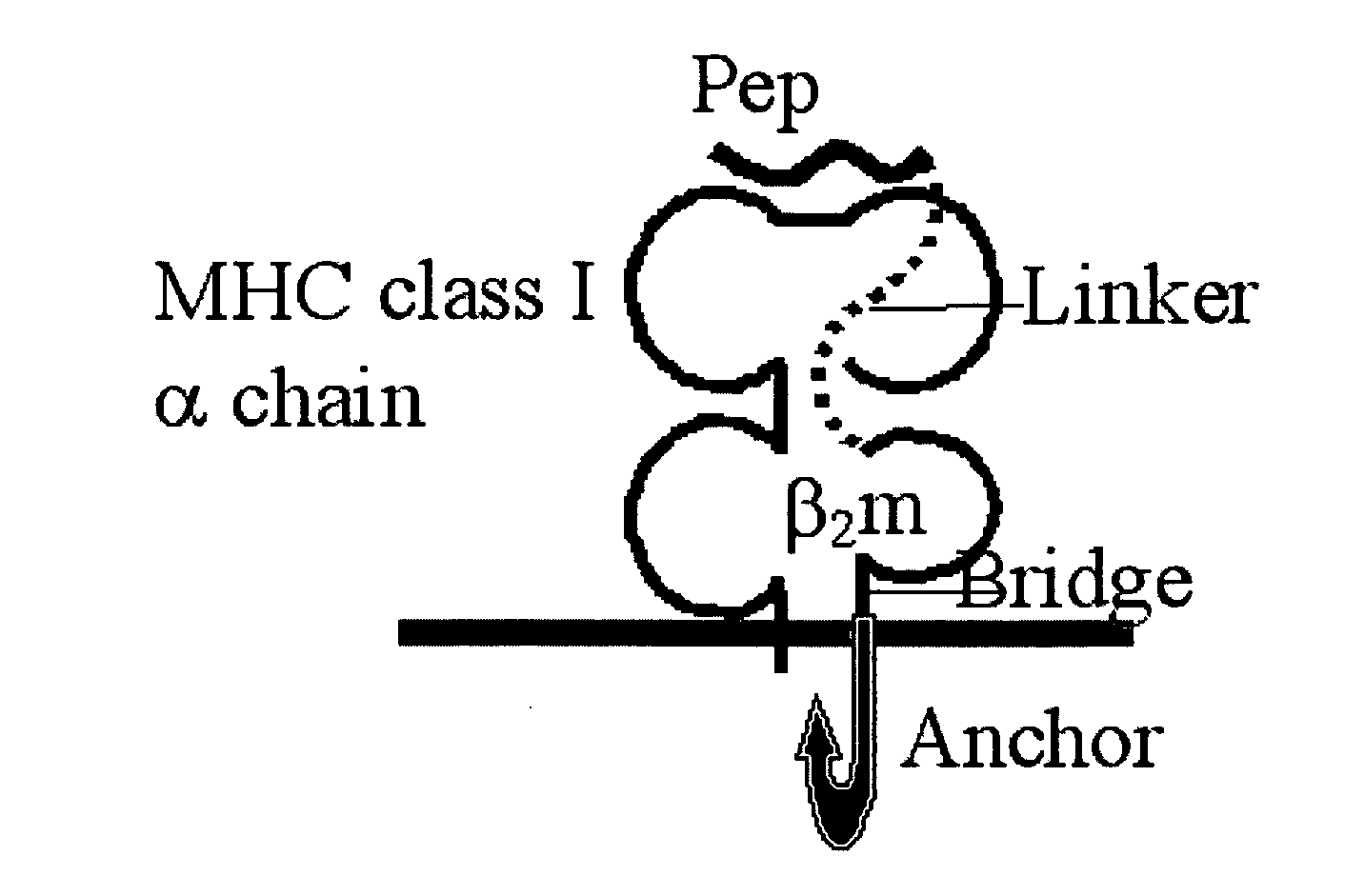Membrane-anchored beta2 microglobulincovalently linked to MHC class I peptide epitopes
a beta2 microglobulin and mhc class i technology, applied in the field of immunology, can solve the problems of not enriched taa-derived peptides of potential clinical benefits, failure to induce therapeutic ctls, and inability to deduce useful information for broader implementation, and achieve the effect of high-level presentation of antigenic peptides
- Summary
- Abstract
- Description
- Claims
- Application Information
AI Technical Summary
Benefits of technology
Problems solved by technology
Method used
Image
Examples
example 1
Expression of dcβ2m Designed for T Cell Re-Programming
[0195]The general schemes of genetic constructs encoding dcβ2m and of the polypeptide product associated with an MHC class I heavy chain are illustrated in FIG. 1. Table 1 summarizes all different single and double chimeric β2m expression plasmids generated in this system as well in the tumor experimental system, which will be described below.
TABLE 1Double and single chimeric β2m constructsand transfected clones expressing themCellPeptideAlleleβ2mAnchor(H-2)CloneHa255-262H-2KkhumannoneMD45(k / d)840-7Ha255-262H-2KkhumanCD3 ζMD45427-24NP50-57H-2KkhumanCD3 ζMD45425-44InsulinH-2KdmouseCD3 ζMD45829S-36B15-23OVA257-264H-2KbmouseH-2KbRMA-S(b)Y314-7OVA257-264H-2KbhumanH-2KbRMA-SY317-2TRP-2181-188H-2KbmouseH-2KbRMA-SY313-10TRP-2181-188H-2KbhumanH-2KbRMA-SY318-7none—humanCD3 ζRMA-SKD21-4, 6none—humanH-2KbRMA-SD323-4none—humanmCD40A20RB340none—humanmTLR4RAW264.7GA467none—humanhTLR4THP-11499none—humanmTLR2RAW264.7GA518gp100209-217HLA-A2humanH...
example 2
Construction and Expression of dcβ2m Molecules Harboring Antigenic Peptides of the B16 Mouse Melanoma Model
[0199]The APCs for the animal studies are based on the commonly used RMA and RMA-S H-2b cell lines. In the animal experiments, focus is on a mouse melanoma expressing a natural Kb-restricted, TAA-derived peptide, and, as a control for peptide specificity, a derivative of the same mouse melanoma is employed presenting another, highly immunogenic Kb-restricted peptide, following DNA transfection.
[0200]B16 is a spontaneous murine (m) melanoma originating in C57BL / 6 mice. B16-F10.9 is a high metastatic line of B16, which shows a low cell surface expression of H-2Kb, and K1 is a low metastatic B16 variant, expressing high level of H-2Kb following DNA transfection (Porgador et al., 1989). TRP-2 was recently identified as a tumor rejection antigen for the B16 melanoma (Bloom et al., 1997). TRP-2181-188, (VYDFFVWL—the peptide of SEQ ID NO: 43, in which the residue S at the amino termin...
example 3
Evaluating Contribution of Membrane Anchorage of β2m to MHC Class I Stability
[0225]In the experimental system described in WO 01 / 91698, a plasmid was assembled, designated 21-2, which encodes a membranal hβ2m, linked to the transmembrane and cytoplasmic region of mouse CD3 ζ chain. Another plasmid, 323-3 was assembled, in which the CD3 ζ portion was replaced with those of H-2Kb. This was done as follows:
[0226]Scheme of genetic constructs encoding these single chimeric β2m (scβ2m) derivatives and of their expected polypeptide products associated with an MHC class I heavy chain are illustrated in FIG. 6.
[0227]Plasmid 21-2 was introduced into RMA-S cells. Following FACS analysis of G418-resistant transfectants with the anti-hβ2m antibody, two clones, designated KD21-4 and KD21-6, were chosen, the latter expressing higher level of membranal β2m. These two clones were analyzed for the ability of the scβ2m product to stabilize the MHC class I molecule H-2D at 37° C. Results of a typical e...
PUM
| Property | Measurement | Unit |
|---|---|---|
| Antigenicity | aaaaa | aaaaa |
Abstract
Description
Claims
Application Information
 Login to View More
Login to View More - R&D
- Intellectual Property
- Life Sciences
- Materials
- Tech Scout
- Unparalleled Data Quality
- Higher Quality Content
- 60% Fewer Hallucinations
Browse by: Latest US Patents, China's latest patents, Technical Efficacy Thesaurus, Application Domain, Technology Topic, Popular Technical Reports.
© 2025 PatSnap. All rights reserved.Legal|Privacy policy|Modern Slavery Act Transparency Statement|Sitemap|About US| Contact US: help@patsnap.com



